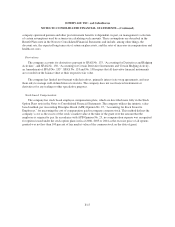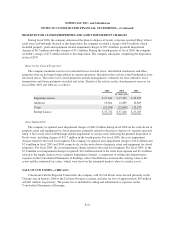Albertsons 2006 Annual Report Download - page 59
Download and view the complete annual report
Please find page 59 of the 2006 Albertsons annual report below. You can navigate through the pages in the report by either clicking on the pages listed below, or by using the keyword search tool below to find specific information within the annual report.SUPERVALU INC. and Subsidiaries
NOTES TO CONSOLIDATED FINANCIAL STATEMENTS—(Continued)
Fiscal Year:
The company’s fiscal year ends on the last Saturday in February. The company’s first quarter consists of 16
weeks, while the second, third and fourth quarters each consist of 12 weeks, except for the fourth quarter of fiscal
2004, which consisted of 13 weeks. The last three fiscal years consist of the 52-week period ending February 25,
2006, the 52-week period ending February 26, 2005, and the 53-week period ending February 28, 2004.
Revenue Recognition:
Revenues from product sales are recognized at the point of sale for retail food and upon shipment of the
product for food distribution. Revenues from services rendered are recognized immediately after such services
have been provided.
Revenues and costs from third party logistic operations are recorded in accordance with EITF issue
No. 99-19, “Reporting Revenue Gross as a Principal Versus Net as an Agent”. Generally, when the company is
the primary obligor in a transaction, is subject to inventory and/or credit risk, has latitude in establishing price
and selecting suppliers, or has several, but not all of these indicators, revenue is recorded gross. If the company is
not the primary obligor and amounts earned have little or no credit risk, the company generally records the net
amounts as management fees earned.
Cost of Sales:
Cost of sales includes cost of inventory sold during the period, including purchasing and distribution costs
and shipping and handling fees.
Advertising expenses are a component of cost of sales in the Consolidated Statements of Earnings and are
expensed as incurred. Advertising expenses were $79.2 million, $80.8 million and $83.4 million for fiscal 2006,
2005 and 2004, respectively.
The company receives allowances and credits from suppliers for volume incentives, promotional allowances
and, to a lesser extent, new product introductions which are typically based on contractual arrangements covering
a period of one year or less. Volume incentives and promotional allowances earned, based on quantities
purchased, and new product allowances are recorded as a reduction to the cost of purchased inventory and
recognized when the related inventory is sold. Promotional allowances that are based on the sell-through of
products are recognized as a reduction of cost of sales when the products are sold.
Cash and Cash Equivalents:
The company considers all highly liquid investments with maturities of three months or less at the time of
purchase to be cash equivalents.
Allowances for Losses on Receivables:
Management makes estimates of the uncollectibility of its accounts and notes receivable portfolios. In
determining the adequacy of its allowances, management analyzes the value of the collateral, customer financial
statements, historical collection experience, aging of receivables and other economic and industry factors.
Although risk management practices and methodologies are utilized to determine the adequacy of the allowance,
it is possible that the accuracy of the estimation process could be materially impacted by different judgments as
to collectibility based on the information considered and further deterioration of accounts.
F-14
























